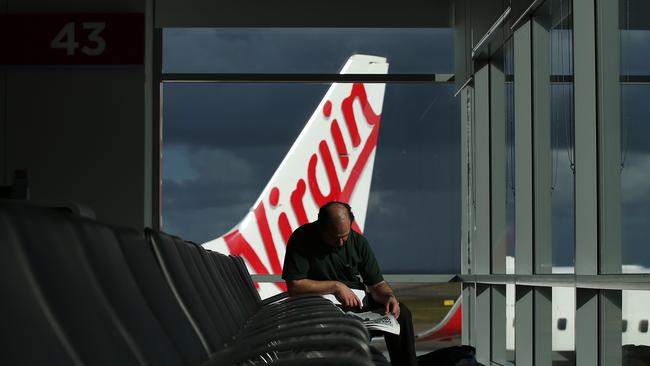Uncertainty over Virgin’s flight path
A review of Virgin must look at whether its capital structure is behind its inability to generate cash, or its strategy, or both.

One of the intriguing questions from last week’s announcement that Virgin Australia’s major shareholders have lent it $425 million to give it liquidity while its board oversees a review of its capital structure, is whether that review will be purely focused on the group’s balance sheet.
The need for the 12-month loan facility was generated by Virgin’s negative free cash flows in the December half, when $253m leaked out of the group, despite the plunge in jet fuel costs and relatively benign competitive environment in the domestic market. Its experience was in stark contrast to Qantas’ soaring free cash flows.
In announcing the review, Virgin’s chairman, Elizabeth Bryan, said it would include an assessment of the appropriate mix of debt and equity capital and operational initiatives to enhance cash flow and profitability.
One suspects the review will have to look more deeply than that and consider whether it is the group’s capital structure that is at the heart of its inability to generate cash, its strategy or both.
While Bryan noted that the $62.5m statutory profit the group posted in the first half of this financial year was its best since 2010, it is worth noting that Virgin Blue, as it was called then, generated exactly that same amount of profit with a balance sheet a third smaller than Virgin has today.
Between then and now, of course, John Borghetti has orchestrated a radical transformation of the group, from what was a leisure-focused, low-cost carrier in 2010, into a full-service, multibrand group today.
Despite the dramatic improvement in the Virgin product since he became chief executive in 2010, there is a continuing question of whether the returns have justified the cost. In the first half of 2010, Virgin had operating expenditures of $1.4 billion. In the December half of this financial year, they were $2.6bn.
Virgin (VAH) is, therefore, a much bigger group with a much higher quality product and, with the acquisitions of Tiger and Skywest, in a stronger strategic position, but it isn’t making any more money than it did in 2010, even though its key airline shareholders pumped $350m of equity into it in 2013 and Virgin itself raised $336m by selling 35 per cent of its loyalty program to private equity in 2014.
The frenetic pace Borghetti has set for the group and the ambitious and all-encompassing nature of the changes he has overseen, are at the core of its balance sheet pressures.
Virgin also hasn’t been helped by its approach to hedging its fuel costs — where it has had far less exposure to the dive in prices than Qantas — or by its exposure to US dollar debt, even as the Australian dollar has depreciated. Those are issues that can probably be addressed, albeit probably at significant cost.
With the Borghetti transformation essentially complete, it is possible that, with another equity injection and a different debt profile, time will improve the returns on the big investment in the strategy.
It would be of some concern to the Virgin board, however, that while Virgin’s upgrading of its product has seen yields rise so have its costs and, therefore, there is a question mark over whether the group has been able to make — and will be able to make in future — a sufficiently large dent in Qantas’ dominance of higher-yielding business passenger volumes to justify the investment in the strategy.
There’s also a question as to whether Virgin’s move up-market is pushing price-conscious volumes towards Jetstar, which produced a record first-half result.
Since the start of the year, Virgin has been offering some aggressive pricing on the key Sydney/Melbourne and Sydney/Perth routes, which may reflect either a desire to protect its share of price-sensitive passengers or, perhaps, a more intense focus on cash generation.
Borghetti has been able to drag Tiger into profit, which is no mean achievement, but he and his board would be very aware that both Qantas’ domestic business and its Jetstar brand are generating operating margins that are far fatter than Virgin’s and which continue to improve relative to Virgin’s.
They may also look closely at Virgin’s international operations which, while relatively small, generate losses that are quite material in the context of Virgin’s size — they lost $30.8m at the underlying earnings before interest and tax level in the first half.
If the conclusion of the review is that the issue is Virgin’s capital structure, then that can be fixed. Either the key shareholders — Air New Zealand, Etihad, Singapore Airlines and Virgin Group — inject more equity or, perhaps, there is another selldown of Virgin’s equity in its Velocity loyalty program to its partner, Affinity Equity Partners.
It may be that, with Borghetti having essentially completed the transformation he envisaged, that a more intense focus on generating cash and profits from what Virgin is today rather than continuing to invest in upgrading and expanding its product offering could be part of the response.
The need for the injection of liquidity from its shareholders while the review is undertaken during a period where there is capacity discipline within the core domestic markets and fuel costs have plunged, signals that Virgin needs something more than more equity and its shareholders are hard-nosed enough to want comfort that they will receive an acceptable return on any new capital they provide.
Whether that’s a period of introspection to digest the dramatic expansion of the past five years or some finetuning of the current structure and strategy to focus more on cash generation, Virgin’s board and those key shareholders would be very aware that the airline industry is such that today’s benign conditions could easily and quickly deteriorate and that they need to build some resilience into the group’s balance sheet and operations before that can occur.



To join the conversation, please log in. Don't have an account? Register
Join the conversation, you are commenting as Logout